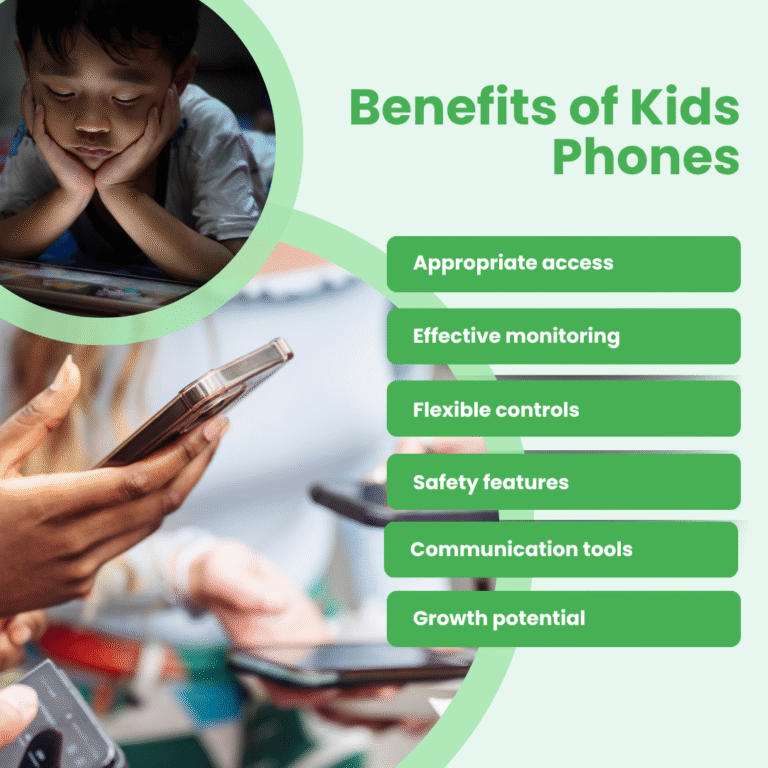Parents everywhere face the same dilemma: when is the right time to give their child a phone, and what kind of phone should it be? With growing concerns about screen addiction, cyberbullying, and online predators, many parents are turning to “dumbphones” as a seemingly perfect solution. These basic devices promise simplicity and safety—but do they really solve all the problems of modern digital parenting?
Let’s take a closer look at why basic phones might not be the complete answer you’re looking for, and what alternatives might better serve both you and your child in today’s connected world.
What Exactly Are Dumbphones?
Basic phones (often called “dumbphones” to contrast with smartphones) are simple mobile devices that primarily handle calls and text messages. Most models feature physical buttons rather than touchscreens, limited or no internet access, and few if any apps. Popular examples include the Nokia 3310, Alcatel Go Flip, and Light Phone.
These devices appeal to parents because they offer basic communication without the endless distractions and potential dangers of smartphones. They’re typically more affordable and durable too, making them seem like an ideal first phone for children.
The Appeal of Going Back to Basics
It’s easy to see why parents are drawn to basic phones:
Less screen time: Without games, social media, or video streaming, kids can’t spend hours glued to their devices.
Fewer online risks: Limited or no internet access means less exposure to inappropriate content, online predators, and cyberbullying.
Fewer distractions: Basic phones won’t interrupt homework time with constant notifications or tempt kids during school hours.
Budget-friendly: Most basic phones cost significantly less than smartphones, both to purchase and maintain.
Durability: Many basic phones can withstand drops and rough handling better than delicate smartphones.
These benefits are real and valuable. But they tell only part of the story.
Where Basic Phones Fall Short
While basic phones address some concerns, they leave many others unresolved—and can even create new problems:
Limited Parental Oversight
Most basic phones offer few if any parental controls. This means:
- You can’t monitor who your child is texting or calling
- You can’t set time limits on phone use
- You can’t block certain contacts
- You have no visibility into the content of their messages
A child with a basic phone might be having inappropriate conversations or being bullied via text, and you’d have no way to know unless they told you.
Missing Safety Features
Modern parenting often relies on digital tools that basic phones simply don’t offer:
- No GPS tracking to locate your child in an emergency
- No SOS buttons for quick emergency contact
- No ability to check if your child arrived at their destination
- Limited battery life compared to many smartphones
One parent shared: “I gave my 12-year-old a flip phone thinking it was safer, but when he missed his bus and needed directions home, he couldn’t access maps. He ended up asking a stranger for help instead—exactly the scenario I was trying to avoid.”
Social Isolation
Today’s kids coordinate almost everything through group chats and social apps:
- School projects are planned via messaging apps
- Birthday parties and hangouts are organized in group chats
- Friends share photos, videos, and inside jokes through apps
- Clubs and sports teams communicate through dedicated platforms
A middle school teacher notes: “When students don’t have access to the group chat apps, they miss announcements about homework, study groups, and social events. They become unintentionally excluded.”
Educational Disadvantages
Schools increasingly integrate digital tools into education:
- Many teachers use educational apps for assignments
- Research often requires internet access
- School communications frequently happen through portals and apps
- Digital literacy is becoming as important as traditional literacy
A basic phone can’t help with any of these educational needs, potentially putting your child at a disadvantage.
The Workaround Problem
Kids are resourceful. When faced with restrictions, many find workarounds:
- Borrowing friends’ phones to access social media
- Using public computers without supervision
- Creating secret accounts their parents don’t know about
- Using friends’ phones to take and share photos
These workarounds often involve less supervision than if they had appropriate access on their own devices.
Today's Digital Reality for Kids
The world our children navigate is fundamentally different from the one we grew up in. Consider these realities:
Social life is digital: For today’s kids, online and offline social lives aren’t separate—they’re completely intertwined. Group projects, inside jokes, weekend plans, and daily conversations flow seamlessly between face-to-face interactions and digital communications.
Digital citizenship is essential: Children need to learn how to behave responsibly online, just as they learn to behave in person. This includes understanding privacy, respecting others, and recognizing inappropriate content or behavior.
Schools expect digital access: Many teachers post assignments online, require digital submissions, and expect students to collaborate digitally outside of class hours.
Future-ready skills: The ability to navigate digital tools responsibly isn’t just about social life—it’s preparing kids for future education and careers.
A child development specialist explains: “Learning to use technology responsibly is like learning to swim. You wouldn’t throw a child into the deep end without lessons, but you also wouldn’t keep them away from water forever. They need guided experience to develop skills and confidence.”
What Parents Really Need

Rather than simply removing all technology, most families need solutions that provide:
Appropriate access: Kids need some digital access for education, social connection, and developing digital literacy.
Effective monitoring: Parents need visibility into their children’s digital activities and communications.
Flexible controls: As children mature, parents need to be able to adjust restrictions accordingly.
Safety features: Location tracking, SOS functions, and the ability to reach children quickly are important for many families.
Communication tools: Kids need appropriate ways to stay connected with friends and family.
Growth potential: The right solution should be able to grow with your child, offering more freedom as they demonstrate responsibility.
A More Balanced Approach
Instead of choosing between all-or-nothing options (full smartphone vs. basic phone), consider solutions specifically designed for children and families.
MMGuardian Kids Phone offers a thoughtful middle ground with features like:
Customizable app access: Parents can allow educational apps while limiting games and social media.
Content filtering: Built-in tools block inappropriate websites and content.
Communication monitoring: Parents can review texts and calls to spot potential issues like bullying.
Location tracking: Real-time GPS helps parents know their child is safe.
Time limits: Parents can set schedules for when the phone can be used.
Emergency features: SOS buttons and always-available emergency calls provide peace of mind.
One parent shares their experience: “We tried a flip phone first, but our daughter was completely cut off from her friends’ group planning. With her MMGuardian phone, she can use the apps she needs for school and staying connected, but I can still set limits and monitor for safety. It’s been the right balance for our family.”
Beyond the Device: The Bigger Picture
Remember that no device—whether basic phone, smartphone, or something in between—replaces good parenting and open communication. The most effective approach combines:
Ongoing conversations about digital citizenship, online safety, and responsible use
Clear boundaries about when and how devices can be used
Leading by example with your own healthy technology habits
Adjusting privileges as your child demonstrates responsibility
Building trust through open dialogue rather than just restrictions
Finding Your Family's Right Answer
The best solution for your family depends on your specific situation:
- Your child’s age and maturity level
- Your family’s values and priorities
- Your child’s social and educational needs
- Your comfort level with technology
Rather than seeing dumbphones as the perfect solution or smartphones as inevitable, consider the full spectrum of options available today. The goal isn’t to find a one-size-fits-all answer, but to choose tools that support your child’s growth while keeping them safe.
For many families, a phone like MMGuardian’s offers the right balance—providing necessary connections and tools while maintaining appropriate parental oversight. It acknowledges the reality that our children are growing up in a digital world, and our job isn’t to completely shield them from it but to help them learn to navigate it safely.
After all, our ultimate goal isn’t just to protect our kids today—it’s to raise responsible digital citizens who can make good choices tomorrow.






